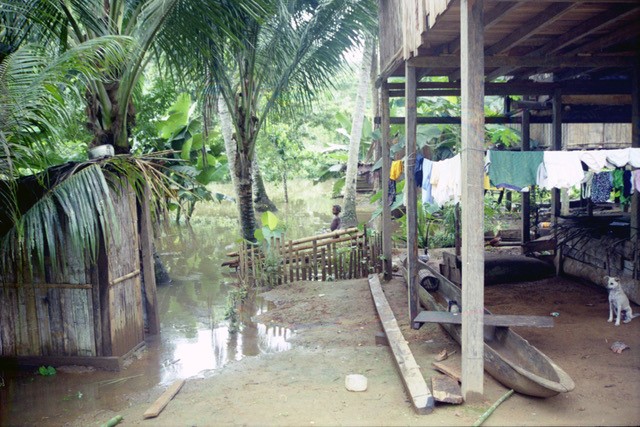
Redoubling efforts to combat diarrhea is a form of climate change adaptation

Photo: A latrine in Ecuador floods after heavy rains, causing sewage to seep into groundwater. Credit: Karen Levy
The world has made substantial progress in combatting diarrhea over the last decade. Climate change is a direct threat to that progress. The World Health Organization suggests that, globally, climate change could cause an additional 250,000 additional deaths per year between 2030 and 2050. Of these, 48,000 additional annual deaths are projected to be caused by diarrhea.
Because diarrheal disease continues to cause nearly 1.5 million deaths every year, even small percentage increases that may come with climate changes can have an immense public health impact. As a water-linked disease, diarrheal disease outbreaks are associated with fluctuations in temperature, heavy rainfall, and flooding. According to the 2021 report of the Intergovernmental Panel on Climate Change, all of these will become more frequent due to climate change, which may cause diarrheal cases to increase. In addition, indirect climate effects such as crop failures or displacement of populations could result in malnutrition and increasingly strained or absent water and sanitation systems, further intensifying the burden of diarrheal disease.
Take E. coli for example. My research team conducted a modeling study that estimated an 8% increase in E. coli diarrhea incidence for a 1°C increase in mean monthly temperature. When we applied our model to just one country—Bangladesh—for this one specific pathogen, we estimated that this increase could be associated with an estimated 800,000 additional annual cases in the near term (2016–2035), and 2.2 million additional annual cases by the end of the century. Adding concern, E. coli is associated with an increased risk of case death as case rates rise. Although these are just estimates, this example illustrates the potential multiplicative effect of increasing global temperatures in regions with already high rates of diarrheal disease.
The good news is that we already have methods to control diarrheal disease. Improvements in water, sanitation, and hygiene (WASH), rotavirus vaccines, ORS and zinc access, and strong nutrition can prevent and treat diarrhea, and we have all these interventions at our disposal now. So, if a disease that we already have methods to control might increase due to climate change, then a redoubling of efforts to combat diarrhea could—and should—be considered a form of climate change adaptation.
Investing in public health approaches to fight diarrhea and other climate-linked diseases now is a no-regrets strategy. WASH, vaccines, essential medicines, and nutrition will provide benefits under both current and potential future climatic conditions. By preventing childhood diarrhea and its long-term consequences—such as stunted growth and impaired immunity—we can give future generations a stronger health foundation and ability to combat infections later in their life, which will further increase resilience to climate change impacts.
In order to most effectively target investments in public health efforts to adapt to climate change, we also need more data. While existing work has examined historical relationships between diarrhea incidence and weather, few studies have projected future disease rates. Even fewer have incorporated social and ecological factors and socioeconomic development pathways into understanding the relationships between climatic factors and diarrhea. By incorporating these components, we will be better able to identify the most vulnerable populations and the most effective adaptation strategies.
In the long run, redoubling investments in primary health care and public health, such as WASH and vaccines, could prove even more essential than developing new climate-specific solutions. These basic measures will strengthen our ability to combat the additional burden of diarrhea and other diseases that climate change brings, while also protecting the gains already made toward defeating diarrhea.


